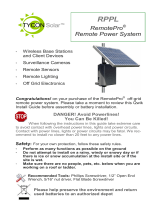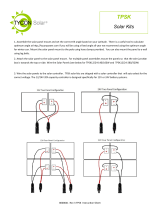Page is loading ...

RPPL-SM
RemotePro®
Remote Power System
▫ Wireless Base Stations and
Client Devices
▫ Surveillance Cameras
▫ Remote Sensors
▫ Remote Lighting
▫ Off Grid Electronics
Congratulations! on your purchase of the RemotePro® off-grid
remote power system. Please take a moment to review this Qwik
Install Guide before assembly or battery installation.
DANGER! Avoid Powerlines!
You Can Be Killed!
When following the instructions in this guide take extreme care
to avoid contact with overhead power lines, lights and power circuits.
Contact with power lines, lights or power circuits may be fatal. We rec-
ommend to install no closer than 20 feet to any power lines.
Safety: For your own protection, follow these safety rules.
▫ Perform as many functions as possible on the ground
▫ Do not attempt to install on a rainy, windy or snowy day or if
there is ice or snow accumulation at the install site or if the
site is wet.
▫ Make sure there are no people, pets, etc. below when you are
working on a roof or ladder.
Recommended Tools: Phillips Screwdriver, 1/2” Open End
Wrench, 5/16” nut driver, Flat Blade Screwdriver
Please help preserve the environment and return
used batteries to an authorized depot

2
Qwik Install
STEP 1: Prepare Enclosure - Attach Battery Brackets
Prepare the Velcro strap and the strap bracket
#5600066. Orient as shown.
Loosen 8 screws holding the mounting plate.
Slide the mounting plate towards you and lift up
on the top end of the mounting plate while sliding
the #5600066 bracket with Velcro Strap over the
end of the mounting plate.
Center the bracket and attach to the mounting
plate using Qty 2 #8 x 3/8 pan head self tapping
screw.
Tighten the Qty 8 mounting plate attach screws.
Position the #5600067 Battery Support Bracket.
If one battery, then ~3 ¾” from the top of the
housing. (~6 ½” if two batteries)
Center the bracket and attach to the mounting
plate using Qty 4 #8 x 3/8 pan head self tapping
screw.
Route the Velcro strap through the slot
in the #5600067 bracket. We recom-
mend not installing the batteries at this
time because it makes the enclosure
heavy and harder to handle. We sug-
gest installing the batteries once the
enclosure is already mounted to a pole.
STEP 2: Prepare Enclosure - Attach Pole Mount Brackets
Caution: Pole mount brackets may have sharp edges, wear gloves.
Attach the pole mount
brackets to the back of
the enclosure using four
flat washers as spacers
under the bracket and
four flat washers and self
tapping screws on top of
the bracket per the in-
structions that came with
the enclosure.

3
STEP 3: Solar Assembly
Assemble the solar mount bracket
per the instructions that came with
the solar mount and attach the so-
lar panel with solar panel junction
box toward the top or left/right side.
Set the bracket angle for your opti-
mum winter angle (Latitude * 0.9 +
30 degrees)
Install the solar assembly to a 2” to
4” pole. Solar panel should be fac-
ing South if in Northern Hemi-
sphere.
STEP 4: Enclosure Mounting
Mount the enclosure to the pole
beneath the solar panel using two
stainless steel hose clamps. Be
sure to leave enough room so that
the enclosure door can open freely.
Mounting the enclosure so that it is shaded by the panel will help re-
duce the maximum temperature inside the box during the hottest part of
the day.
Cut off any extra hose clamp length after tightening to keep a clean in-
stall.
STEP 4: Solar Controller Install
The systems come with two different solar controllers depending on the
model that was ordered. The smaller controller mounts on the backplate
using two or four #8 x 3/8” pan head self tapping screws. The larger
SCPOE controller mounts to the inside of the door using the included
Velcro tape.

4
The kit includes two Cable Gland Feedthroughs. Remove one or two
hole plugs in the bottom of the enclosure and replace with one or two
cable gland feedthroughs to be used to route wires.
Route the included solar panel cable through one of the feedthrough
and attach to the controller SOL inputs. (Red to + and Black to –).
Attach the included battery cable to the controller BAT inputs. (Red to +
and Black to –).
Note: The battery cable is different if one or two batteries and if 12V or
24V configuration. If two batteries and 12V, the batteries are wired in
parallel. If two batteries and 24V, the batteries are wired in series.
12V Configuration
24V Configuration

5
Connect the wires for any equipment, that will be powered by the sys-
tem, to the controller load output on the small controller or Aux and/or
PoE outputs on the large controller.
Mount the controller inside the enclosure with screws or Velcro tape, as
required.
STEP 5: Battery Install
Insert the batter-
ies by slipping
under the Velcro
strap and then
tightening the
strap.
Fold the end of the strap between the battery
and the enclosure wall to allow access to the
end of the Velcro strap for easy removal.
STEP 6: System Startup
Connect any external equipment to the solar controller.
Connect Battery wire negative (Black) to battery terminal negative
(Black). Connect Battery wire positive (Red) to battery terminal positive
(Red). The Solar controller will power up.
(Note: Always connect battery before connecting solar. Disconnect so-
lar before unplugging battery).
After the controller is connected to the battery, you can connect the so-
lar. Push the MC4 solar connectors together until they are fully seated
and snap into place. The connectors are keyed to prevent reverse po-
larity.
Check to make sure you see solar power indicators on the Solar Con-
troller when the sun is hitting the panel. Refer to the documentation that
came with the controllers for operation of the controllers.
If battery voltage is >12V your connected equipment should be pow-
ered up.
STEP 7: Make sure the lid gasket is clean and free from any particles,
then close and latch the cover, making sure that wires are clear of the
gasket area. There is a small combination lock included if you want to
prevent someone from opening the enclosure without you knowing.

6
SPECIFICATION SUMMARY
Subject to change without notice
Model #
Continuous Power
Generation*
Reserve Time
Battery Voltage
PoE Out
AGM Battery
Capacity
Solar Size
RPPL12-9-15 2.5W 21hrs 12V --- 9Ah 15W
RPPL12-18-15 3.2W 34hrs 12V --- 18Ah 15W
RPPL12-18-35 4.3W 25hrs 12V --- 18Ah 35W
RPPL24-18-30 4.3W 25hrs 24V --- 18Ah 30W
RPPL1224-18-15 3.2W 34hrs 12V 24V 18Ah 15W
RPPL1224-18-35 4.3W 25hrs 12V 24V 18Ah 35W
RPPL1248-18-15 3.2W 34hrs 12V 48V 18Ah 15W
RPPL1248-18-35 4.3W 25hrs 12V 48V 18Ah 35W
Model #
Continuous
Power
Generation*
Reserve Time
Battery Voltage
PoE Out
LiFePO4 Battery
Capacity
Solar Size
RPPL12-10L-15 3.75W 24hrs 12V --- 10Ah 15W
RPPL12-10L-35 3.75W 24hrs 12V --- 10Ah 35W
RPPL12-20L-35 7.5W 24hrs 12V --- 20Ah 35W
RPPL1224-20L-35 7.5W 24hrs 12V 24V 20Ah 35W
RPPL1248-20L-35 7.5W 24hrs 12V 48V 20Ah 35W
RPPL24-20L-30 6.5W 27hrs 24V — 20Ah 30W
RPPL2424-20L-30 6.5W 27hrs 24V 24V 20Ah 30W
RPPL2448-20L-30 6.5W 27hrs 24V 48V 20Ah 30W
Lead Acid
Battery
Lithium Battery

7
TECH CORNER
Additional Information you may find useful
1. CONTROLLER: The 12V controller turns off power to the load at
11V and reconnects when the battery reaches 12V. The 24V controller
turns off at 20V and on at 24V. This protects battery from overdis-
charge and increases battery life and performance.
2. CAPACITY: The RemotePro® RPPL-SM with 35W panel and 18Ah
AGM battery is rated at 4.3W continuous power output with 3.5 hours
of peak sun per day. Reserve battery capacity at 4.3W load is 25
hours. Lithium batteries nearly double this capacity.
3. BATTERY MAINTENANCE: The batteries used in the RemotePro®
systems don’t require any maintenance. The AGM should last up to 5
years in normal use while the Lithium should last 10 years. Note: Nev-
er store batteries for any length of time in a discharged state or it
will damage the battery.
4. BATTERY OVERDISCHARGE: We highly recommend hooking all
equipment loads to the controller voltage output. This output will dis-
connect the load if the battery voltage drops below 11V/20V and this
will protect the battery from over-discharge. If batteries get completely
discharged, you will reduce the battery life and you will need to super-
charge them with a good quality 10A automotive battery charger. Don’t
charge for more than 8hrs on an automotive charger. Once they are
back to a normal operating range, the integrated charge controller will
maintain the charge.
8. TROUBLESHOOTING:
A. There is no Load Output?—If battery voltage is too low, the
charge controller will turn off the load outputs. On a 12V battery
system the load will turn off if battery is <11V. On a 24V battery
system the load will turn off at <20V. It won’t turn back on until the
battery voltage exceeds 12V/24V.
B. Why is my solar panel voltage so high?- Open circuit voltage
on a 12V panel is around 23V, and about 40V on a 24V panel.
Once you connect to the charge controller the panel voltage will
be reduced to a little higher than the battery voltage.
C. My system turns off at night and comes back on in the morn-
ing?- This is a sure sign that the solar panels and/or battery ca-
pacity can’t support the load. You should measure your actual
load and recalculate to make sure you have adequate capacity.
9. ACCESSORIES: Tycon® offers a variety of accessories to meet
almost any need. Just visit tyconsystems.com for more info.

8
8000114 Rev 2 RPPL-SM RemotePro® Qwik Install Guide
Limited Warranty
The RemotePro® products are supplied with a limited 36 month warran-
ty which covers material and workmanship defects. This warranty does
not cover the following:
▫ Parts requiring replacement due to improper installation, misuse,
poor site conditions, faulty power, etc.
▫ Lightning or weather damage.
▫ Physical damage to the external & internal parts.
▫ Products that have been opened, altered, or defaced.
▫ Water damage for units that were not mounted according to user
manual.
▫ Usage other than in accordance with instructions and the normal
intended use.
NOTES
/










